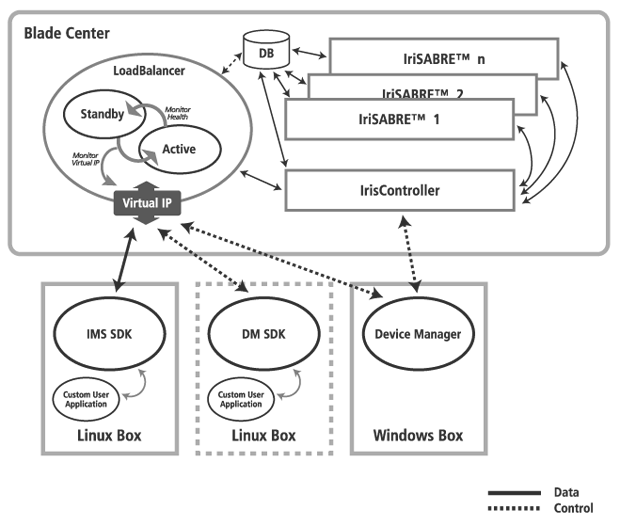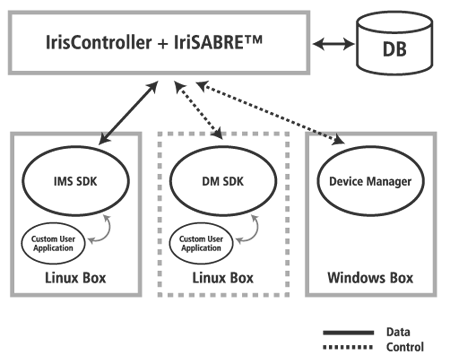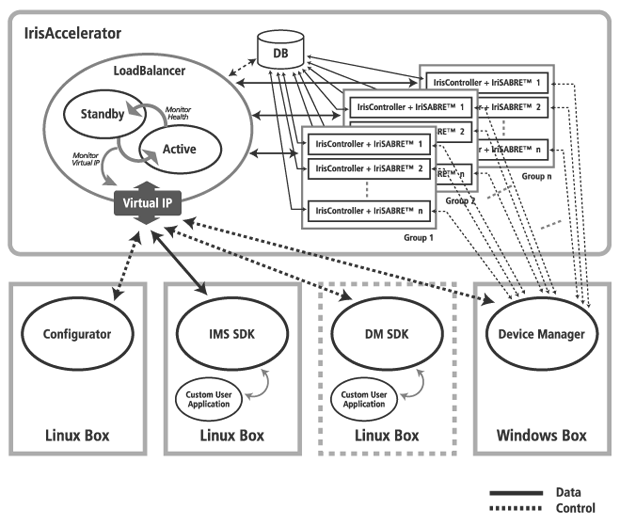IrisAccelerator™
Features
IrisAccelerator is a system that provides a fast iris matching facility using Iris ID’s technology. IrisAccelerator is configurable to supports large population databases of up to 1 billion with hundreds of millions of de-duplication transactions per day. The IrisAccelerator system is a cluster of servers where each server runs multiple matching engines often referred to as ‘Blades’. The IrisAccelerator architecture is designed to be hardware independent. It can be deployed on a “Virtual Machine” to realize economies of scale.
In order to reduce the response time of searching the database, IrisAccelerator™ matches an enrollee’s IrisCode in a parallel fashion.
IrisAccelerator Key Product Features
- Scalability
- High Availability: (No single point of failure)
- Partial Failure Support
- Component Recovery
- Consistency
- Speculative Execution
IrisAccelerator™ system consists of the following modules:
- IrisAccelerator™: A software development Kit that provides the Application Program Interface to communicate with the system. This interface consists of enrollment and identification functions that can be resourced by end user applications to enroll and identify users in the IrisAccelerator™ system.
- IrisController™: The server component that manages the database of users and their IrisCodes. IrisController™ processes the IrisAccelerator™ SDK requests and is a one-point access to the IriSABRE™.
- IriSABRE™: The iris matching module that matches requests against the entire database. All enrollments and IrisCode deletions from the system are updated in the IriSABRE™.
- LoadBalancer: A module that runs on a Linux server machine and is an interface between the IrisAccelerator™ SDK and the cluster of Groups in the IrisAccelerator™ system. The LoadBanancer accepts SDK requests given to the system and forwards these requests to IrisController™s in a “round robin” style (a process that sends its output back to the input source). This module is also responsible for adding a new IrisAccelerator™ Server into the Group, and for removing non-functioning Servers from the Group. This module has a failover protection mechanism that ensures smooth functionality of the cluster.
- IrisAccelerator™ Configurator: An application that provides an interface for configuring (create, delete and modify) the groups and servers in the IrisAccelerator™ system. It displays the list of groups and servers and lets the user create, delete and modify groups and servers in the IrisAccelerator™ system.
- IrisAccelerator™ Device Manager: Commonly referred to as “DM”, the IrisAccess device Manager is an application that provides an interface for control and monitoring of the entire system. It displays the configuration of every server in the Group as well as the active and backup LoadBalancer for the IrisAccelerator™ system.
Iris Accelerator (Turnkey Solution)
- Runs on IBM Blade Server platforms
- Cluster of blade server chassis where each chassis has multiple blades
- All but one blade runs a matching engine
- One blade runs IrisController to control blades within a chassis
- Clusters are made operational by LoadBalancer
- High Availability and Throughput by using multiple chassis
- Scalability by running multiple matching engines within a chassis
- An Oracle database (RAC/standalone) for data storage

IrisAccelerator (Private Cloud Entry Level Solution)
- Matching engines on a ‘pizza box’ servers
- High Throughput and fault tolerant by running matching engines in series (within a group)
- Supports up to 250,000 records
- Upgradeable
- Logging
- Oracle database (RAC/standalone) for data storage

IrisAccelerator (Private Cloud Solution)
- Cluster of matching engines on different ‘pizza box’ servers
- Hardware independent: ‘cloud’ based ABIS engine
- Cluster is made operational by LoadBalancer
- High Availability and Throughput by running matching engines in series (within a group)
- Scalability (> 50 M) by running matching engines in parallel (in different groups)
- Logging (Debug, Info, Error, Transaction)
- SNMP support
- Oracle database (RAC/standalone) for data storage

